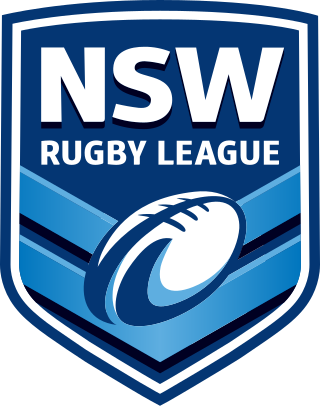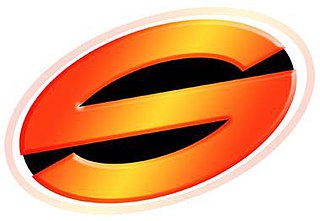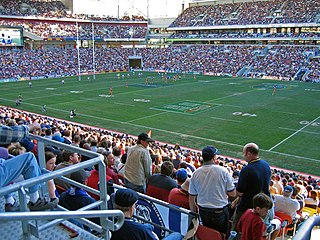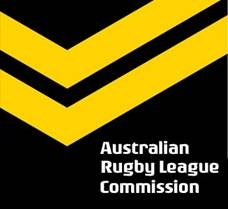
The National Rugby League is a professional rugby league competition in Australasia which contains clubs from New South Wales, Queensland, Victoria, the Australian Capital Territory and New Zealand.

The New South Wales Rugby League Ltd (NSWRL) is an Australian rugby league football competition operator in New South Wales and the Australian Capital Territory and is a member of the Australian Rugby League Commission. It was registered on 21 December 1983 and succeeded the New South Wales Rugby Football League which had been formed in Sydney on 8 August 1907. The NSWRFL and then NSWRL operated Sydney's, then New South Wales' and eventually Australia's premier rugby league club competition from 1908 to 1994. The organisation administers the New South Wales rugby league team.

Super League was an Australian rugby league football administrative body that conducted professional competition in Australia and New Zealand for one season in 1997. Along with Super League of Europe, it was created by News Corporation during the Super League war which arose following an unsuccessful attempt to purchase the pay television rights to rugby league in Australia. After two years of legal battles the competition was played for a single season in 1997 alongside the rival Australian Rugby League (ARL) competition before the two merged in 1998 to form the National Rugby League (NRL).

Football in Australia refers to numerous codes which each have major shares of the mainstream sports market, media, broadcasting, professional athletes, financial performance and grassroots participation: Australian rules football, rugby league, rugby union and soccer. There are four pre-eminent professional football competitions played in Australia: the Australian Football League, the National Rugby League, Super Rugby and the A-League (soccer). Rugby League is the most watched sport in Australia based on television viewership, however, Australian football attracts larger live attendences. In the states of New South Wales and Queensland, rugby football is overall the most watched and receives the most media coverage, especially the Rugby League State of Origin contested between the two states referred to as "Australian sport's greatest rivalry". In recent times, there has been an increase in popularity in Australian football and corresponding decrease in popularity of Rugby union in New South Wales and Queensland. Soccer, while extending its lead in participation rate, particularly in the large cities, and improving its performance at the FIFA World Cup and at the FIFA Women's World Cup, continues to attract the overall lowest attendance, as well as media and public interest, of the four codes.

Laurie William Daley AM, also known by the nicknames of "Lozza" and "Loz", is an Australian professional rugby league football coach and a former player who played as a centre and five-eighth in the late 1980s, 1990s, and early 2000s.

The Adelaide Rams was an Australian professional rugby league football club based in Adelaide, South Australia. The team was formed in 1995 for the planned rebel Super League competition. The Rams lasted two seasons, the first in the Super League competition in 1997 and the second in the first season of the National Rugby League (NRL) in 1998. The Rams were not a successful club, winning only 13 out of 42 games. However crowd numbers in the first season were the fifth highest of any first-grade club that year, but dwindled to sixteenth in the second season. The Adelaide club was shut down at the end of the 1998 season as a result of poor on-field performances, dwindling crowd numbers, financial losses and a reduction in the number of teams in the NRL. They remain the only team from the state of South Australia to have participated in top-level rugby league in Australia.
The history of the National Rugby League (NRL), the top league of professional rugby league football clubs in Australasia, goes back to December 1997, when it was formed in the aftermath of the Super League war of the mid-1990s. The NRL has, in its relatively brief history, enjoyed growth and record attendance figures.

The 1995 ARL premiership was the 88th season of professional rugby league football in Australia, and the first to be run by the Australian Rugby League following the hand-over of the Premiership's administration by the New South Wales Rugby League. For the first time since 1988, the Premiership expanded again, with the addition of two new clubs from Queensland; North Queensland Cowboys, based in Townsville, and South Queensland Crushers, based in Brisbane. And for the first time ever outside the borders of New South Wales and Queensland, and indeed, Australia, the addition of two other new clubs from Western Australia, Western Reds, based in Perth, and from Auckland, Auckland Warriors, based in Auckland. This saw a total of twenty teams, the largest number in the League's history, compete during the regular season for the J J Giltinan Shield, which was followed by a series of play-off finals between the top eight teams that culminated in a grand final for the Winfield Cup between the newly re-branded Sydney Bulldogs and the Manly-Warringah Sea Eagles.
The Australian rugby league premiers are the winners of the top grade competition in Australian rugby league, which is currently the National Rugby League. From 1908 until 1995, when the ARL Premiership was formed, there were two premiers, one each from Sydney and Brisbane. This occurred again in 1997 during the Super League war.

Rugby league football has been played and watched by people in the Australian state of Victoria since the early 20th century. While for most of its history there the game's popularity has been marginal due to the dominance of Australian rules football in Victoria, rugby league's popularity has rapidly increased in recent years in the state's capital of Melbourne, due mainly to the introduction of a professional Melbourne-based team in the national competition. The governing body is NRL Victoria.

In Queensland, Rugby league was introduced in 1908 and is the most watched winter sport in the state and the second most participated football code after soccer. Within its first decade it surpassed rugby union there to become the most popular football code as players switched to play professionally in the Queensland Rugby League (QRL). In the 1920s, Queenslanders began leaving to play professionally in the New South Wales Rugby League which became a more popular competition. However Queensland maintained a strong rugby league culture, with the state continuing to perform well in interstate rugby league. The later advent of the State of Origin series ensured that players would return to represent their state. Regarded as “Australian sport's greatest rivalry”, the term "Origin fever" is used by the media to describe the passion of the Queenslanders public for the competition and the chant "Queenslander!", attributed to Billy Moore in 1995, has become the state's battle cry. The Queensland Rugby League is the governing body and has 58,912 registered tackle players. Rugby league authorities often count an additional 70,000 registered touch football players as participants, though that sport is only loosely affiliated and is governed by Touch Football Queensland.

Rugby league in New South Wales is the most popular spectator sport in the state, with the attendance and television audiences exceeding that of the various other codes of football. There are over 400,000 active rugby league participants, with a further 1 million playing the sport in schools, placing the sport second only to soccer for the most played sport in the state. There are more than 500 active clubs, ten of which are professional teams competing in the National Rugby League (NRL).
In Western Australia, rugby league is played at amateur level by 31 clubs across 5 regional leagues with a total of around 7,900 players. It attracts an audience mainly for the State of Origin series.
Rugby league in South Australia describes the sport of Rugby league, which is played at amateur level in the state of South Australia. Rugby League has been played in South Australia since the 1940s. The governing body is NRL South Australia.
The Super League war was a commercial competition between the Australian Rugby League (ARL) and the Australian Super League to establish pre-eminence in professional rugby league competition in Australia and New Zealand in the mid-1990s.

The Australian Rugby League Commission Limited (ARL), formerly the Australian Rugby Football League Limited known as the Australian Rugby League is an Australian rugby league football competition operator. It was founded in 1986 as the Australian Rugby Football League Limited and succeeded the Australian Rugby Football League Board of Control which had been formed in 1924. Since its inception, the ARL has administered the Australian national team and represented Australia in international rugby league matters. Prior to 1998, the code in Australia had been principally administered by individual state leagues on a domestic basis, and the ARL on a national and international basis.

The NRL State Championship is a rugby league match contested by the premiers of the two elite second-tier competitions in Australia, the New South Wales Cup and the Queensland Cup. The match has been played as a curtain-raiser to the NRL Grand Final at Stadium Australia since it was introduced by the National Rugby League (NRL) in 2014. The match acts as Super Bowl-type to determine the National Reserve Grade Champions.
Women's rugby league is a popular women's sport in Australia. The sport has a high level of participation in the country both recreational and professional. Australian Rugby League Commission (ARLC) is the national governing body of the sport in Australia, organising the Australian Women's Rugby League, the Australian women's national team, and the nine state governing bodies of the game, among other duties. Women's participation of modern rugby league has been recorded since the early 1920s. It has since become one of Australia's most popular women's team sports.
Kylie Hilder is an Australian former rugby league footballer who is head coach of the New South Wales Women's State of Origin team.


















